Before we begin
Edge cases are often the reason infosec professionals have jobs and understanding those edge cases can be a career path all on its own. For me, exploring these edge cases can make for some very interesting research. This post is the result of nearly a year’s worth of pulling different threads trying to learn as much as I can about phishing, punycode, and spoofing domains. My hope for this post is to document some of the interesting information I’ve found over the last year or so and maybe teach you a thing or two. If you enjoy this post, let me know on twitter!
Table of Contents
- Introduction To This Blog
- A Very Brief Overview of Domain Squatting
- Intro To Punycode
- Punycode, Big Problems
- Punycode Proof Of Concept
- Setting Up The Punycode Domain
- Moving To EC2
- Cloning Youtube
- Getting A Valid SSL Certificate
- The Meta Tag Problem
- Parting Thoughts
A Very Brief Overview Of Domain Squatting
Before we get into the interesting part of this research, we very briefly need to talk about domain squatting/typo squatting. Domain squatting is a fairly common technique that is sometimes used by nefarious people for various purposes such as stealing business, preying on those who mistype a URL, or simply to cause chaos. In fact, my domain has been squatted which you can read about here if you’d like. Some common techniques for domain squatting are as follows:
- Bitsquatting: Swapping one or two letters in a domain name with similar characters. grahamhelton.com -> grahannhelton.com
- Repetition: Duplicating a letter in a domain name. grahamhelton.com -> grahamhellton.com
- Omission: Omitting a letter in a domain name. grahamhelton.com -> grahamheton.com
You’re smart, you get the point. These are some of the more well
known techniques that everyone knows of. There is a famous case of
someone registering a domain goggle.com (a very common
misspelling of google.com) that for years was a website
that had all kinds of sketchy redirects and adware pages. So how could
this be taken one step further?
Intro To Punycode
During a phishing engagement, it is fairly common to buy a domain very similar to the company you are phishing. This can be done through any of the aforementioned techniques domain squatting techniques, but what if you want to take this one step further? What if you wanted to get a domain that was nearly identical to your target? Well first we need to talk about ASCII (sorry…).
The internet was first created in the United States where we have an alphabet that contains characters A-Z with some numbers and special characters mixed in there. There was really no need for non-English letters to be used in domain names so ASCII characters were used when setting up protocols.
This was all fine and dandy until other countries began accessing the internet and people quickly realized that ASCII characters would not suffice. For example, what happens if someone wants to register a domain in a different language such as Vietnamese? This presents a problem because the Vietnamese alphabet has many characters that are not available in the ASCII character set such as:
Unmarked | A/a, Ă/ă, Â/â, E/e, Ê/ê, I/i, O/o, Ô/ô, Ơ/ơ, U/u, Ư/ư, Y/y
Grave Accent | À/à, Ằ/ằ, Ầ/ầ, È/è, Ề/ề, Ì/ì, Ò/ò, Ồ/ồ, Ờ/ờ, Ù/ù, Ừ/ừ, Ỳ/ỳ
Hook Above | Ả/ả, Ẳ/ẳ, Ẩ/ẩ, Ẻ/ẻ, Ể/ể, Ỉ/ỉ, Ỏ/ỏ, Ổ/ổ, Ở/ở, Ủ/ủ, Ử/ử, Ỷ/ỷ
Tilde | Ã/ã, Ẵ/ẵ, Ẫ/ẫ, Ẽ/ẽ, Ễ/ễ, Ĩ/ĩ, Õ/õ, Ỗ/ỗ, Ỡ/ỡ, Ũ/ũ, Ữ/ữ, Ỹ/ỹ
Acute Accent | Á/á, Ắ/ắ, Ấ/ấ, É/é, Ế/ế, Í/í, Ó/ó, Ố/ố, Ớ/ớ, Ú/ú, Ứ/ứ, Ý/ý
Dot Below | Ạ/ạ, Ặ/ặ, Ậ/ậ, Ẹ/ẹ, Ệ/ệ, Ị/ị, Ọ/ọ, Ộ/ộ, Ợ/ợ, Ụ/ụ, Ự/ự, Ỵ/ỵSo how can you register domains with these characters if you can only
have a domain with ASCII characters? Introducing punycode! Punycode is a
funny little encoding syntax for non-ASCII domains. It was first defined
in March 2003 in RFC3492.
Essentially, all this encoding scheme does is convert a non-ASCII
character such as ê into a format that only contains ASCII
characters, thus making it compatible with pre-existing protocols such
as DNS. An example of this encoding would be changing
hêllo.com to xn--hllo-gpa.com after punycode
encoding. Essentially, punycode adds xn-- to the beginning
of the domain, removes the non-ASCII letter, and encodes it at the end
with -<encoded value>.com This means when you’re
buying a domain with a non-ASCII character, you’re actually buying the
punycode equivalent. This can cause some unexpected issues down the line
if you don’t know much about punycode domains before buying one. You can
play around with punycode encoding using this calculator.
Punycode, Big Problems
Buying a domain with punycode is a novel concept but in practice, it can cause a few issues that you should be aware of before a phishing engagement.
- You should know what software your target is using before deciding if a punycode encoded domain is right for you.
- Different software handles punycode encoded domains differently. For
example, typing
https://ỵoutube.comin slack will automatically render intohttps://xn-outube-ot8b.com. Interestingly, receiving a punycode link in protonmail does not show the punycode encoded version.
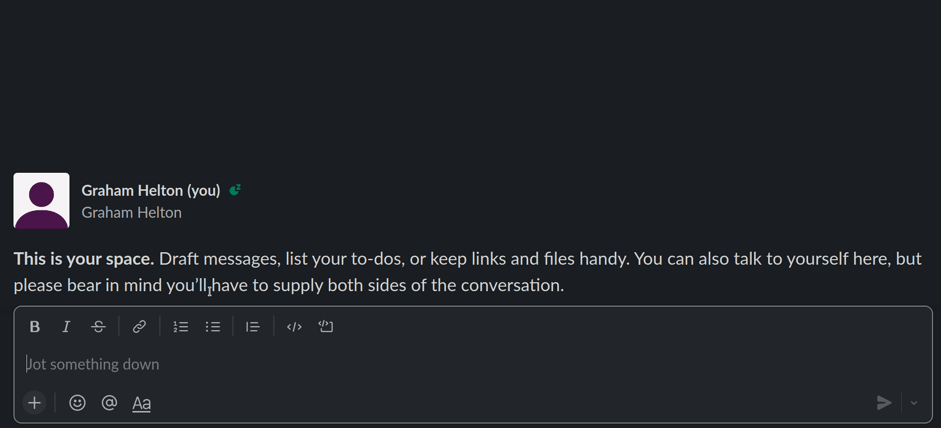

- This behavior could end your campaign before it begins. If you spend time creating a phishing campaign with a specially crafted domain that has a non-standard character, your campaign can quickly blow up in your face if slack takes all your hard work and encodes it with punycode.
- A savvy security team could force the translation of non-standard
characters into punycode in URL bars.
- This will make it so any link someone clicks will only show the
encoded version of the domain which will be a red flag for most people.
- In firefox this can be achieved by entering
about:config-> searching forIDN_show_punycode-> Changing from False to True. This will makehttps://ỵoutube.comappear in its encoded format.https://xn-outube-ot8b.com
- In firefox this can be achieved by entering

- When conducting a phishing campaign, you’ll be sending emails. Some email sending services such as mailgun do not support punycode encoded domains.
Punycode Proof Of Concept
With the theoretical knowledge out of the way, I wanted to give a high level overview of setting up a domain with non-standard characters. This isn’t meant to be a step by step tutorial but should allow you to recreate my steps if you really want to.
When I first learned that you could buy domains using non-standard
ASCII characters I found AltCodeUnicode.com. This is a site
where you can find all kinds of non-standard ASCII characters. After
some poking around I thought a good proof of concept project could be
ỵoutube.com (Notice the non-standard ỵ character)
was available for $12. So of course I bought it. For science.
Setting Up The Punycode Domain
Originally I was trying to use the method I talk about in this blog post to host a simple static site using an amazon S3 bucket but for various reasons this failed.
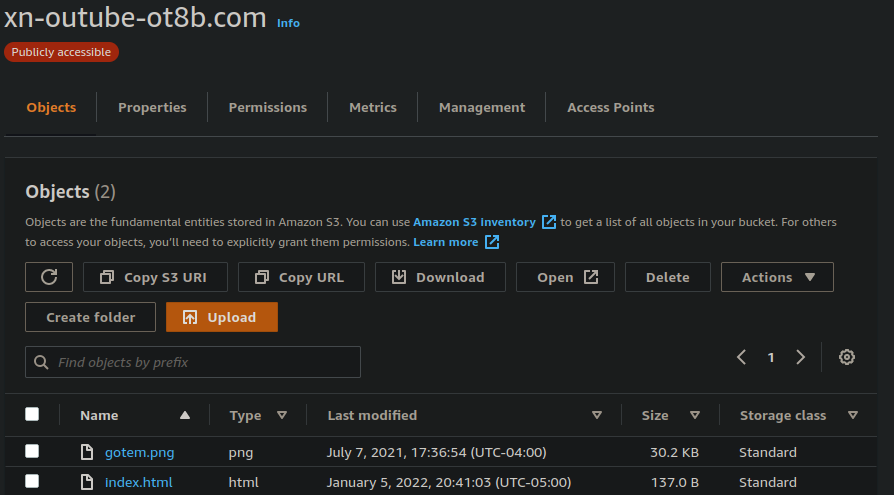
I will save you the hours of troubleshooting why this wasn’t working, but the moral of the story is that according to the AWS bucket naming requirements this technically works for creating a bucket but doesn’t seem to work for hosting a static site in that bucket. This is probably for the best since I wanted to do more than just server web pages. I figured hosting a site using a classic LAMP stack on an EC2 instance would work well and I shouldn’t run into too many weird AWS specific errors.
Moving To EC2
Hosting the site using an EC2 instance was the logical next step
because it should have less bizarre constraints since you can
just point your DNS A record to the IP address of your EC2 instance.
Before I jumped head first into creating an nginx server, I wanted to
test to see if I would encounter any issues routing the punycode domain
(xn–outube-ot8b.com) to an EC2 IP. Fortunately, it was fairly straight
forward to get this working now that I didn’t need to battle any odd S3
bucket nuances. Here is what my DNS record looked up after creating a
hosted zone for xn--outube-ot8b.com.

After waiting nearly 24 hours for DNS to update and wondering if I
was doing something wrong, I could finally issue
dig ỵoutube.com and dig xn--outube-ot8b.com.
Now that DNS was up, I could visit the site in firefox by creating a
quick python server using sudo python3 -m http.server 80. I
am still not sure if the punycode domain took longer to update in DNS
servers around the world than a normal domain name but I’ve never had to
wait longer than a few minutes for DNS. It was most likely just a
coincidence though.
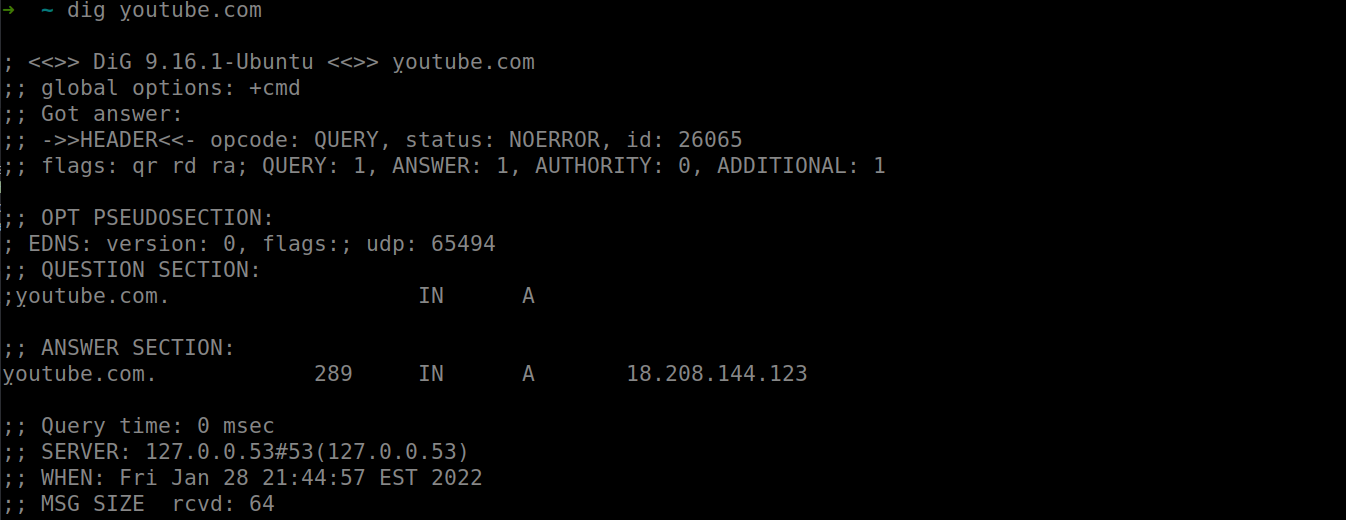

Knowing that I could create a server using this domain means I can do a lot in terms of what I actually wanted to host on the page. If you were creating a phishing engagement you could host the company’s login page, host malicious files, etc.
Cloning Youtube
Now that I’ve verified that I can host a web server using the
punycode encoded domain xn--outube-ot8b.com
(ỵoutube.com) I needed to figure out what I wanted
to host on this sever. Depending on your use case you may want to be
creating a login page but for this example I just wanted to see how
accurate of a clone I could make of youtube.com. My first thought was to
use wget to download a youtube video page. This
theoretically could have worked but messing with the HTML/CSS to get it
looking just right was very tedious.

Eventually I was tired of fiddling around with those pages I
downloaded using wget and found a github repo
with a decent looking clone of youtube that was easy to edit. Next, I
cloned this into my EC2 instance and began making some quick changes to
the HTML and devising a plan to host it.
You could create an nginx/apache webserver (and I would
recommend that if you’re not just doing research), but since this was
more of a proof of concept, I decided to stick with a simple python
server for now. The only problem was that when running
sudo python3 -m http.server 80, you would see the youtube
clone but the URL would be a dead giveaway since it was simply
ỵoutube.com without a video ID. To remedy this, I just
created a folder with the name corresponding to what I wanted in the
URL. In this case watch?v=D5iap5aO4i99. Now all I needed to
do was start the web server using the previously mention python command,
and navigate to the site. It looks fairly realistic but will need a lot
of altering as well as a valid SSL certificate.
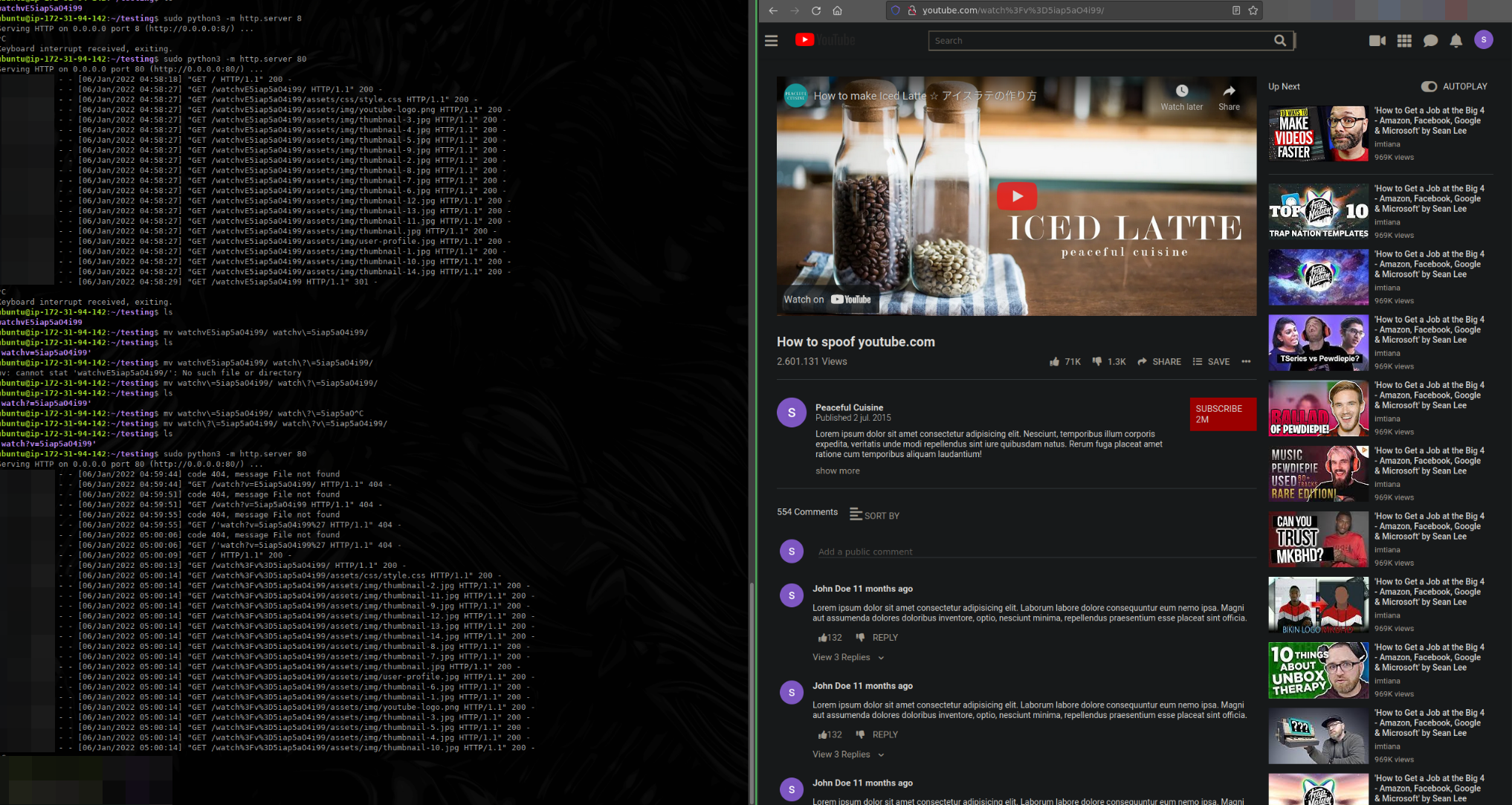
Getting A Valid SSL Certificate
The biggest glaring issue is the lack of a valid SSL certificate and
thus we might see a warning saying that this site might be insecure and
we don’t see the lockpad in the browser. Fortunately, using LetsEncrypt
makes this fairly simple even when you’re just using a python command to
host your server. I found a great writeup from CornerPirate
that explains some extra info about how this works. After installing
certbot, run the certbot command, fill out the information
required for a certificate and then create a new python web server using
twisted web on port 443, making sure to specify the path to keys.
sudo python3 -m twisted web --https=443 --path=. -c /etc/letsencrypt/live/xn--outube-ot8b.com/fullchain.pem -k /etc/letsencrypt/live/xn--outube-ot8b.com/privkey.pemThat’s it! Super easy way to get a certificate for you web server!
The Meta Tag Problem
My original idea for this research actually had nothing to do with hosting a spoofed site, it actually was just supposed to be a way for me to figure out how meta tags worked. A meta tag (or meta element) is just an HTML element that allows you to add metadata to a web page. This can be almost anything but sites like twitter/facebook/linkedin do special things with meta tags. For example, whenever I post a blog to twitter you’ll notice that it is usually accompanied by a nice little image preview. This is accomplished through meta tags. To get this working, you use a standardized set of meta tags that twitter will parse to render the image. For example, here is how mine are set up.

Meta tags I use for my site
<meta name="twitter:card" content="summary_large_image"/>
<meta name="twitter:image" content="https://www.grahamhelton.com/roundup6Twittercard.png"/>
<meta name="twitter:title" content="Weekly Security Roundup #6: January 23rd-30th 2022"/>
<meta name="twitter:description" content="Reading/Writing but not executing (rw-)"/>
<meta property="og:title" content="Weekly Security Roundup #6: January 23rd-30th 2022" />
<meta property="og:description" content="Reading/Writing but not executing (rw-)" />
<meta property="og:type" content="article" />
<meta property="og:url" content="https://www.grahamhelton.com/blog/roundup6/" />
<meta property="og:image" content="https://www.grahamhelton.com/roundup6Twittercard.png" />
<meta property="article:published_time" content="2022-01-30T00:00:00+00:00" />
<meta property="article:modified_time" content="2022-01-30T00:00:00+00:00" />Twitter has many different “Cards” that will display content in a
number of different ways. When you post a link to youtube, you get a
“player card”. When you post a link to github you get a “summary card”.
You can read more about
them here. Wouldn’t it be cool if I could post a link to
ỵoutube.com and have twitter automatically pull the meta
tags to display whatever video was on that page in the “player” twitter
card just like it does for youtube? You’ve surely seen this, but you
might not have know it had anything to do with meta tags. Typically the
player card looks something like this.

I attempted to add “player card” meta tags to
ỵoutube.com but was running into strange errors when trying
to get them working on twitter. Twitter has a very handy [card
validator] (https://cards-dev.twitter.com/validator) that you can use to
test your twitter cards before posting the links. Unfortunately, I could
not get these working using a simple python server or an nginx server.
I’m not totally sure how to fix this or if it is possible.
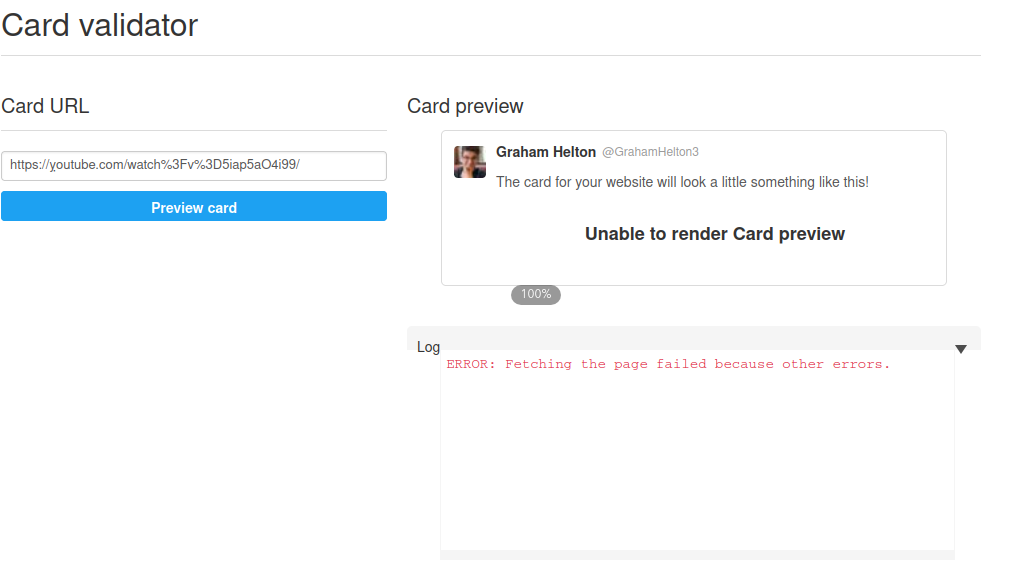
It should be noted that it is against twitter’s security policy to post a phishing link or links that “mislead people”
The final product
After spending some time editing the HTML template, I even got some comments that weren’t placeholder text/images. Obviously being able to add your “own” comments/views/likes on a video people think is on youtube is not great but also there is not much you can do about it. Here is a quick comparison of a real youtube video to my spoofed one. Left is the spoofed site, right is the real one.

Parting Thoughts
- I do not like working with DNS/web servers.
- Working with DNS/web servers is very time consuming because a lot of times you’re waiting for DNS records to update which in this case took ~24ish hours.
- Working with meta tags can be a pain.
- Working out the kinks with meta tags can also be frustrating since twitter’s card validator will sometimes cache meta tags for up to a week. This can make testing different ones very time consuming
- Punysquatting can be very powerful, but it can also be quite frustrating.
- Setting up a domain with non-standard ASCII characters can be a pain to set up correctly and requires a lot of work. It might be a better time investment to buy a look-a-like domain
- Generally I think one of the only valid uses for a punysquatting domain is phishing.
- Domain squatting typically is successful due to people mistyping a URL but with a punycode domain, its unlikely (at least for those with a standard keyboard) to mistype a domain with a non-standard character
- Your browser typically automatically converts punycode encoded
domains such as
xn--outube-ot8b.cominto their non encoded formỵoutube.com.
- This allows for emoji domains such as i❤️tacos.ws.
- An interesting note is that if a webserver does not exist on that
domain, most browsers only show the punycode encoded domain. For
example, when I turn the web server on for
ỵoutube.com, firefox will render it with the Vietnameseỵcharacter. However, if I do not have a webserver turned on, Firefox does not changexn--outube-ot8b.comtoỵoutube.com.
Quick note: The web server used to host
ỵoutube.comis no longer live which means you cannot visit the site since this was just for research!
I had a fun time over the past few months doing this research and I learned a ton. If you have any questions about this post, please don’t hesitate to reach out to me on twitter.